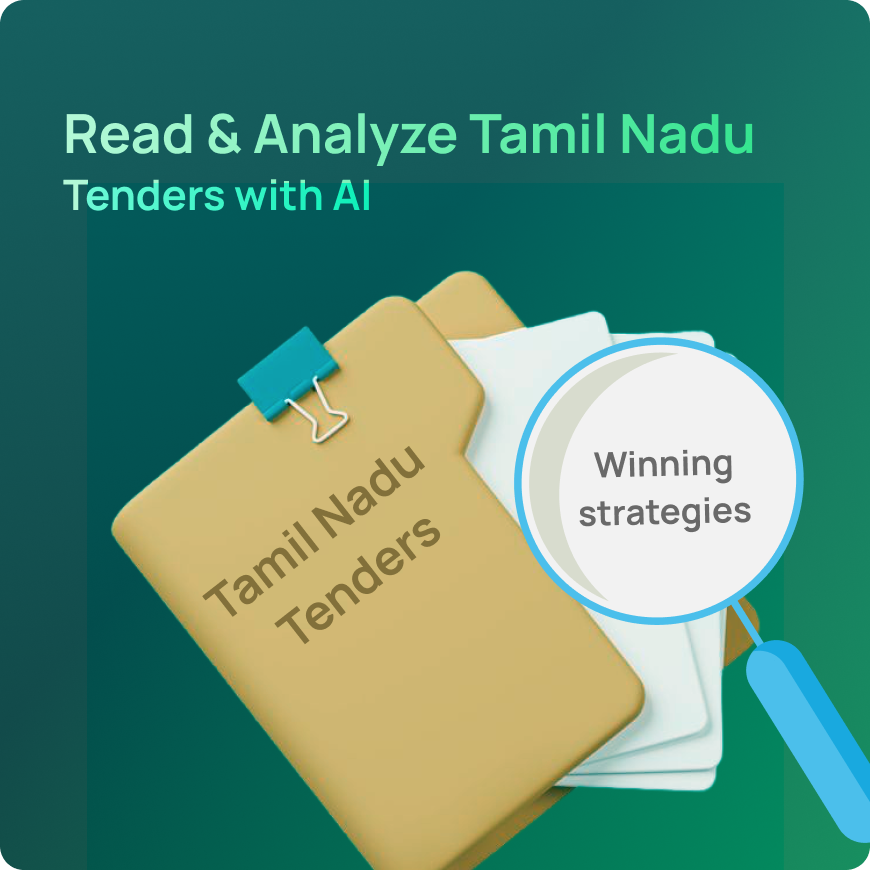How to Read and Analyse Tamil Nadu Tenders Using AI?
Tamil Nadu has over 9,800 live tenders. Learn the strategies to read, analyse, and win them using thorough preparation and advanced AI tools.

Introduction
Tamil Nadu is one of India’s most active states in public procurement, offering thousands of tender opportunities across sectors. In fact, Tamil Nadu had over 9,870 live government tenders open for bidding around mid-2024. For contractors, CFOs, and CXOs looking to win contracts - whether state-wide Tamil Nadu tenders or local Chennai tenders - success starts long before you submit a bid. It begins with carefully reading tender clauses, identifying risks, and asking the right pre-bid queries. This comprehensive guide will walk you through optimized strategies for bidding on Tamil Nadu tenders, including how to interpret tender documents, mitigate risks, and even leverage AI for translation and analysis. By the end, you’ll be better prepared to craft winning bids that meet all requirements and avoid costly pitfalls.
Understanding Tamil Nadu’s Tendering Process
Tamil Nadu’s e-Procurement System: Most government tenders in Tamil Nadu are routed through the official eProcurement portal (TNePS). This portal enables you to search for tenders by department, location, or category, download tender documents (often called Tender Schedules), and submit bids online. For example, at any given time, the Chennai Metropolitan Development Authority (CMDA) and other Chennai-based departments may have multiple tenders listed on the portal. All tenders above certain thresholds (e.g., ₹25 lakhs for works, ₹10 lakhs for goods) are required to follow the Tamil Nadu Transparency in Tenders Act, 1998, and its rules, ensuring a fair and transparent process for bidders.
Registration and Digital Signatures:
To bid online, you must register on the portal and obtain a valid Digital Signature Certificate (DSC). The portal guidelines emphasize enrolling with an e-token (digital certificate) from a certified authority and mapping it to your account. Make sure to complete your registration and DSC setup well in advance, as these are prerequisites for accessing tender documents and submitting bids. Once registered, you can maintain commonly required documents (like GST registration, past project certificates, etc.) in the portal’s “My Documents” section and attach them to bids as needed.
Finding Relevant Tenders: If you are specifically targeting Chennai tenders or tenders in certain districts, use the portal’s filters by location or department. For instance, you can filter tenders issued by Greater Chennai Corporation or other city agencies. Note that Chennai’s municipal body also publishes a weekly Tender Bulletin listing local works tenders, and some organizations (like Chennai Port Trust or Chennai Metro Rail) may have their own e-tender portals. However, the state’s central portal remains the primary hub for Tamil Nadu tenders, aggregating opportunities from all departments statewide.
Statistics - Scope of Opportunities:
Tamil Nadu’s government bodies regularly float a high volume of tenders, reflecting robust development activity. For example, in just the first quarter of FY2024, Tamil Nadu entities issued 7,743 e-tenders worth about ₹9,456 crore. Such numbers underscore the vast opportunities available. Whether it’s infrastructure projects, supply contracts, or service consultancies, being proactive and thorough in your bidding approach can position your company to secure a share of these contracts.
Reading Tamil Nadu Tender Documents Thoroughly
Once you have identified a suitable tender, the first critical step is to read the tender document thoroughly, every page and clause. Tender documents (also called RFPs, bid documents, or tender schedules) contain detailed instructions and requirements that you must follow to the letter. In fact, the Tamil Nadu eProcurement portal explicitly advises bidders: “After downloading the tender schedules, the bidder should go through them carefully and then submit the documents as per the tender document; otherwise, the bid will be rejected.” Skimming is not an option; missing a single clause could lead to a non-compliant bid and outright rejection.
Key Sections to Focus On:
While every part of the tender is important, pay special attention to these common critical sections:
- Eligibility Criteria: Check the minimum qualifications required, such as past experience, annual turnover, certifications, etc. Ensure your company meets these criteria before you invest time in the bid. Scope of Work & Technical Specifications: Understand exactly what work or supplies the tender is asking for. Specifications might be technical (for construction, IT systems, equipment supply, etc.) - read them line by line.
- Timeline and Milestones: Note the project duration, delivery schedules, or milestone dates. Can you realistically meet them? Aggressive timelines might imply higher costs or require more resources - factors to consider in your bid pricing (and potential risks if timelines are missed).
- Payment Terms: Cash flow is vital. See how and when payments will be released (e.g., stage payments, on delivery, after completion, etc.). Government tenders often have specific payment schedules and may withhold a percentage until final acceptance. Unfavorable payment terms (like very delayed payments) could impact your financing - identify these upfront.
- Earnest Money Deposit (EMD) and Fees: Most tenders demand an EMD (bid security) as a sign of serious bidding. Check the EMD amount or percentage and mode of payment (online, bank guarantee, etc.). Tamil Nadu tenders typically require you to arrange the EMD as specified and submit the original instrument (if offline) to the department before the bid deadline. Missing the EMD or submitting it incorrectly will disqualify your bid. Also note any tender fee or processing fee and how to pay it.
- Contract Terms and Conditions: These include clauses on liquidated damages (penalties for delay), performance security (additional deposit after winning, to ensure contract performance), warranties, dispute resolution, etc. Read these clauses word-for-word. They define your obligations and liabilities if you win the contract.
- Bid Submission Instructions: Understand the format and contents of the bid to be submitted. Tenders often have two parts: Technical Bid (qualification documents, technical proposal) and Financial Bid (price quote), usually submitted separately online. Follow instructions on document formatting, file uploads, and required forms or declarations. The Tamil Nadu eProcurement guide reminds bidders to submit all documents in the required formats (PDF, XLS, etc.) and not to tamper with the provided BOQ (Bill of Quantity) Excel sheets. Even minor deviations (like modifying the BOQ template or missing a form) can lead to rejection.
Common Mistake:
Overlooking any attached annexures or addenda. Tender documents may include drawings, annexures, or referenced standards. Ensure you review those as well. If the tender has multiple volumes (e.g. Volume I: Instructions, Volume II: Technical Requirements, Volume III: Draft Contract), read all volumes. It’s not uncommon for critical clauses to be buried in annexures or draft contracts.
In summary, treat the tender dossier as the law of the bid. A methodical reading, perhaps with a checklist of all compliance points, will save you from costly mistakes. One study of construction tenders found that bid documents often contain errors, omissions, or discrepancies (e.g. incorrect or missing information) that create uncertainties and project risks. Given that bidding periods are usually short, many bidders fail to resolve all these uncertainties hidden in the documents in time, especially if the document quality is poor. The only way to catch these issues is through diligent, slow reading and note-taking on every requirement.
AI Tender Analysis: Leveraging Technology for Better Bids
Beyond translation, AI technologies can assist in analyzing tender documents and formulating a stronger bid strategy. Large tender documents - sometimes hundreds of pages of technical specs, contract conditions, and forms - can be daunting. Modern AI tools, however, are capable of rapidly scanning, extracting, and summarizing information from tender documents, which can greatly enhance your efficiency and insight as a bidder.
For example, AI systems can automatically scan tender documents and extract relevant information into a structured format. Instead of manually combing through pages for each requirement, an AI tool might pull out all instances of “eligibility criteria” or list all technical specifications in a separate summary. This ensures you don’t overlook any critical detail. It also reduces human error - an AI isn’t likely to skip a paragraph by accident, whereas a human reader might. According to a 2025 industry analysis, AI-powered software can analyze thousands of pages in minutes, flagging key terms and compliance requirements so that no crucial detail is overlooked.
Natural Language Processing (NLP) for Summarization:
One particularly useful subset of AI is NLP, which can summarize complex, jargon-filled documents into concise points. Tender documents, especially for technical projects, often have dense language. NLP tools can highlight essential details, for instance, summarizing a 50-page technical standard into a one-page brief of requirements. This helps you quickly understand what the client truly prioritizes. It can also highlight obligations buried deep in text (say, an obscure clause requiring a specific certification). By parsing language patterns, AI can sometimes catch inconsistencies or missing information in the tender, serving almost like an automated compliance checklist. If an important section is ambiguous or seems contradictory, the AI’s output might help you spot that, so you know to raise a query or adjust your bid accordingly.
Risk Analysis and Bid/No-Bid Decisions:
Advanced AI tools even incorporate predictive analytics. By learning from historical tender data and outcomes, AI might estimate the likelihood of bid success or identify high-risk elements of a tender. For example, an AI platform could analyze past tenders of the same department to tell you that projects of a certain size tend to be awarded to companies with specific credentials - info that helps you gauge your chances or any gaps in your profile. Some tools highlight risk factors like unusually strict clauses or unrealistic requirements by comparing them with a database of similar tenders. While human judgment is still paramount, these AI insights can support your bid/no-bid decision and strategy (allowing you to focus on tenders where you have a better chance or to plan improvements in your proposal).
In summary, AI tender analysis can give you a competitive edge by accelerating document review, highlighting hidden requirements, and even improving the quality of your bid. As one procurement expert noted, leveraging AI can “reduce the time spent on administrative tasks and ensure no critical details are overlooked”, as well as “summarize lengthy documents and highlight essential details” for quicker understanding. In the high-stakes world of tendering, such efficiencies and insights can translate into more bids submitted, higher compliance, and ultimately more wins.
Conclusion
Bidding on Tamil Nadu tenders - or any tenders, for that matter - is as much an art as a science. It requires a blend of meticulous attention to detail (reading every clause, understanding every requirement) and strategic decision-making (identifying risks, deciding what to clarify, how to price, and when to leverage tools like AI). By thoroughly reading tender documents, you ensure your bid will be compliant and complete. By interpreting risks in those documents, you protect your company from unpleasant surprises and choose your battles wisely. And by formulating clear pre-bid queries, you actively shape the tender conditions and eliminate ambiguities, rather than passively accepting them.
In Tamil Nadu’s robust tender landscape, those who take the time to “read the fine print” and seek clarifications are the ones who consistently turn opportunities into successful contracts. Complementing these efforts with technology, from using AI translation for Tamil-language content to deploying AI analysis for complex tenders, can further boost your efficiency and effectiveness, allowing you to handle more bids with confidence.
As you implement these practices, remember that every tender is a learning experience. Win or lose, each bid teaches you more about how Tamil Nadu’s procurement works and how you can improve. With the guidance outlined above, you are well-equipped to approach Tamil Nadu and Chennai tenders in 2025 and beyond with greater clarity, lower risk, and a higher chance of success. Good luck with your bidding!



